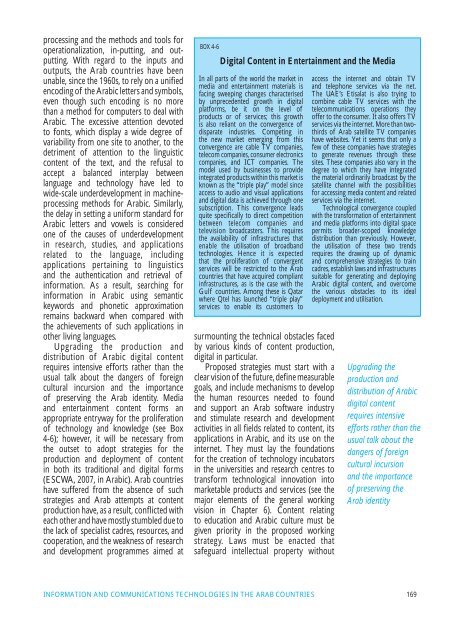Arab Knowledge Report 2009: Towards Productive
Arab Knowledge Report 2009: Towards Productive
Arab Knowledge Report 2009: Towards Productive
- No tags were found...
Create successful ePaper yourself
Turn your PDF publications into a flip-book with our unique Google optimized e-Paper software.
processing and the methods and tools foroperationalization, in-putting, and outputting.With regard to the inputs andoutputs, the <strong>Arab</strong> countries have beenunable, since the 1960s, to rely on a unifiedencoding of the <strong>Arab</strong>ic letters and symbols,even though such encoding is no morethan a method for computers to deal with<strong>Arab</strong>ic. The excessive attention devotedto fonts, which display a wide degree ofvariability from one site to another, to thedetriment of attention to the linguisticcontent of the text, and the refusal toaccept a balanced interplay betweenlanguage and technology have led towide-scale underdevelopment in machineprocessingmethods for <strong>Arab</strong>ic. Similarly,the delay in setting a uniform standard for<strong>Arab</strong>ic letters and vowels is consideredone of the causes of underdevelopmentin research, studies, and applicationsrelated to the language, includingapplications pertaining to linguisticsand the authentication and retrieval ofinformation. As a result, searching forinformation in <strong>Arab</strong>ic using semantickeywords and phonetic approximationremains backward when compared withthe achievements of such applications inother living languages.Upgrading the production anddistribution of <strong>Arab</strong>ic digital contentrequires intensive efforts rather than theusual talk about the dangers of foreigncultural incursion and the importanceof preserving the <strong>Arab</strong> identity. Mediaand entertainment content forms anappropriate entryway for the proliferationof technology and knowledge (see Box4-6); however, it will be necessary fromthe outset to adopt strategies for theproduction and deployment of contentin both its traditional and digital forms(ESCWA, 2007, in <strong>Arab</strong>ic). <strong>Arab</strong> countrieshave suffered from the absence of suchstrategies and <strong>Arab</strong> attempts at contentproduction have, as a result, conflicted witheach other and have mostly stumbled due tothe lack of specialist cadres, resources, andcooperation, and the weakness of researchand development programmes aimed atBOX 4-6Digital Content in Entertainment and the MediaIn all parts of the world the market inmedia and entertainment materials isfacing sweeping changes characterisedby unprecedented growth in digitalplatforms, be it on the level ofproducts or of services; this growthis also reliant on the convergence ofdisparate industries. Competing inthe new market emerging from thisconvergence are cable TV companies,telecom companies, consumer electronicscompanies, and ICT companies. Themodel used by businesses to provideintegrated products within this market isknown as the “triple play” model sinceaccess to audio and visual applicationsand digital data is achieved through onesubscription. This convergence leadsquite specifically to direct competitionbetween telecom companies andtelevision broadcasters. This requiresthe availability of infrastructures thatenable the utilisation of broadbandtechnologies. Hence it is expectedthat the proliferation of convergentservices will be restricted to the <strong>Arab</strong>countries that have acquired compliantinfrastructures, as is the case with theGulf countries. Among these is Qatarwhere Qtel has launched “triple play”services to enable its customers tosurmounting the technical obstacles facedby various kinds of content production,digital in particular.Proposed strategies must start with aclear vision of the future, define measurablegoals, and include mechanisms to developthe human resources needed to foundand support an <strong>Arab</strong> software industryand stimulate research and developmentactivities in all fields related to content, itsapplications in <strong>Arab</strong>ic, and its use on theinternet. They must lay the foundationsfor the creation of technology incubatorsin the universities and research centres totransform technological innovation intomarketable products and services (see themajor elements of the general workingvision in Chapter 6). Content relatingto education and <strong>Arab</strong>ic culture must begiven priority in the proposed workingstrategy. Laws must be enacted thatsafeguard intellectual property withoutaccess the internet and obtain TVand telephone services via the net.The UAE’s Etisalat is also trying tocombine cable TV services with thetelecommunications operations theyoffer to the consumer. It also offers TVservices via the internet. More than twothirdsof <strong>Arab</strong> satellite TV companieshave websites. Yet it seems that only afew of these companies have strategiesto generate revenues through thesesites. These companies also vary in thedegree to which they have integratedthe material ordinarily broadcast by thesatellite channel with the possibilitiesfor accessing media content and relatedservices via the internet.Technological convergence coupledwith the transformation of entertainmentand media platforms into digital spacepermits broader-scoped knowledgedistribution than previously. However,the utilisation of these two trendsrequires the drawing up of dynamicand comprehensive strategies to traincadres, establish laws and infrastructuressuitable for generating and deploying<strong>Arab</strong>ic digital content, and overcomethe various obstacles to its idealdeployment and utilisation.Upgrading theproduction anddistribution of <strong>Arab</strong>icdigital contentrequires intensiveefforts rather than theusual talk about thedangers of foreigncultural incursionand the importanceof preserving the<strong>Arab</strong> identityINFORMATION AND COMMUNICATIONS TECHNOLOGIES IN THE ARAB COUNTRIES169
















